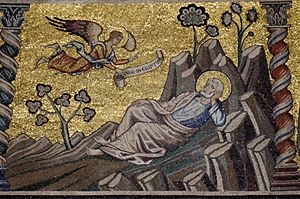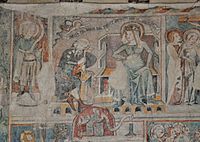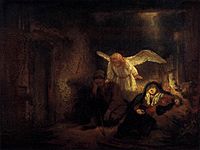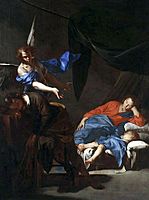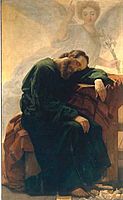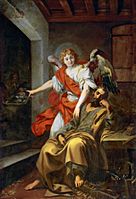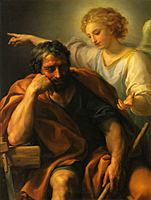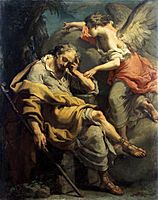Saint Joseph's dreams facts for kids
Saint Joseph's dreams are four special dreams described in the Gospel of Matthew in the New Testament. In these dreams, an angel of the Lord visits Joseph, who was Jesus's earthly father. The angel gives Joseph important instructions and warnings about danger.
All four dreams happened around the time of Jesus's birth and early life. This was between when Mary became pregnant and when the family returned from their trip to Egypt. These dreams are often called "Joseph's first dream," "second dream," and so on. The first dream is sometimes called the Annunciation to Joseph. This is because an angel announced something important to him, just like an angel announced Jesus's birth to Mary.
The Four Important Dreams

Here are the four dreams Joseph had:
- First dream: In Matthew 1:20-21, an angel told Joseph not to be afraid to marry Mary. The angel explained that Mary's baby was from the Holy Spirit. This dream helped Joseph understand God's plan.
- Second dream: In Matthew 2:13, an angel warned Joseph to leave Bethlehem quickly. He was told to flee to Egypt because King Herod wanted to harm Jesus.
- Third dream: In Matthew 2:19-20, while Joseph and his family were in Egypt, an angel appeared again. The angel told him it was safe to go back to Israel. King Herod had died, so Jesus was no longer in danger from him.
- Fourth dream: In Matthew 2:22, Joseph was warned in another dream not to go back to Judea. Instead, he was told to go to the region of Galilee. This is why Jesus grew up in Nazareth.
Dreams in Art
Artists have shown Joseph's dreams in paintings and other artworks. These scenes are not as common as other stories from the Life of Jesus in art or the Life of the Virgin. Sometimes, it's hard to tell which dream an artist is showing.
The second dream, where Joseph is told to flee to Egypt, is probably shown most often. If a painting doesn't say which dream it is, it's often this one. If Mary is in the picture, especially if she looks pregnant, it might be the first dream. This dream usually takes place indoors.
If the scene is outside, it might be the second dream. Sometimes, the angel points away from the picture, telling Joseph to leave. Tools from Joseph's carpentry workshop are often shown. This usually means it's the second dream. Also, if an ox or a donkey from the Nativity scene is there, it often points to the second dream.
-
Bernardo Cavallino, around 1645. This might be the 3rd dream.
-
The 2nd dream, by Daniele Crespi, 1620–1630.
-
Mengs, 18th century
Famous Artworks of Joseph's Dreams
Some famous paintings of Joseph's dreams include:
- Joseph's Dream (Crespi), from the 1620s, showing the 2nd dream.
- Joseph's Dream (Rembrandt, 1645).
- Joseph's Dream, (Studio of Rembrandt, 1650–1655).
- Dream of Saint Joseph, (de La Tour, 1628–1645).
See also
 In Spanish: Sueños de San José para niños
In Spanish: Sueños de San José para niños


